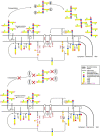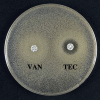VanA-type vancomycin-resistant Staphylococcus aureus
- PMID: 19506057
- PMCID: PMC2772335
- DOI: 10.1128/AAC.00346-09
VanA-type vancomycin-resistant Staphylococcus aureus
Abstract
Since 2002, nine methicillin (meticillin)-resistant Staphylococcus aureus (MRSA) strains that are also resistant to vancomycin (VRSA) have been reported in the United States, including seven clinical isolates from Michigan. The strains harbor a plasmid-borne Tn1546 element following conjugation from a glycopeptide-resistant Enterococcus strain. In the second step, Tn1546 transposed to a resident plasmid in five strains; the acquired plasmid behaved as a suicide gene delivery vector, and the incoming DNA had been rescued by illegitimate recombination. Surprisingly, combination of a glycopeptide with a beta-lactam has a strong synergistic effect against VRSA, both in vitro and in an animal model, despite resistance of the strains to both drug classes when administered separately. This results from the fact that the late peptidoglycan precursors ending in D-alanine-D-lactate (D-Ala-D-Lac) that are mainly synthesized in the presence of glycopeptide inducers are not substrates for PBP2', which is the only transpeptidase that remains active in the presence of oxacillin. One VRSA strain is partially dependent on vancomycin for growth due to a mutation in the host D-Ala:D-Ala ligase, thus having to rely on the inducible resistance pathway for cell wall synthesis. Competition growth experiments in the absence of inducer between the MRSA recipient and isogenic VRSA transconjugant revealed a disadvantage for the transconjugant, accounting, in part, for the low level of dissemination of the VRSA clinical isolates. The association of multiple molecular and environmental factors has been implicated in the regional emergence of VRSA in Michigan.
Figures





References
-
- Aligholi, M., M. Emaneini, F. Jabalameli, S. Shahsavan, H. Dabiri, and H. Sedaght. 2008. Emergence of high-level vancomycin-resistant Staphylococcus aureus in the Imam Khomeini Hospital in Tehran. Med. Princ. Pract. 17:432-434. - PubMed
-
- Arthur, M., F. Depardieu, P. Reynolds, and P. Courvalin. 1996. Quantitative analysis of the metabolism of soluble cytoplasmic peptidoglycan precursors of glycopeptide-resistant enterococci. Mol. Microbiol. 21:33-44. - PubMed
-
- Arthur, M., P. E. Reynolds, and P. Courvalin. 1996. Glycopeptide resistance in enterococci. Trends Microbiol. 4:401-407. - PubMed
Publication types
MeSH terms
Substances
Grants and funding
LinkOut - more resources
Full Text Sources
Other Literature Sources
Medical

